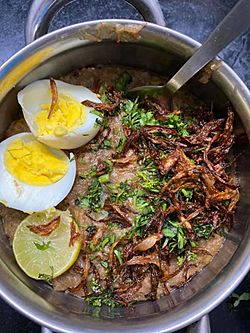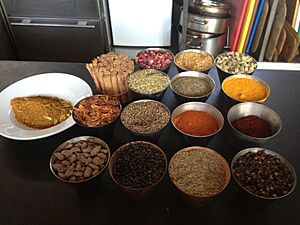Hyderabadi haleem facts for kids

Hyderabadi Mutton Haleem garnished with Cilantro, Egg, Fried Onion, and Lime.
|
|
| Alternative names | Hyderabadi Harees |
|---|---|
| Place of origin | India |
| Region or state | Hyderabad, Telangana |
| Created by | Originated from the Chaush (Hyderabadi Arabs) |
| Main ingredients | Pounded wheat, lentils, goat meat, ghee, dried fruit and saffron |
Hyderabadi haleem is a special kind of haleem stew. It is very popular in the city of Hyderabad, India. This thick stew is made with meat, lentils, and pounded wheat. It becomes a smooth, paste-like dish.
Haleem originally came from Arab countries. It was brought to Hyderabad by the Chaush people. This happened when the Nizams ruled Hyderabad State. Over time, local Indian spices were added. This made Hyderabadi haleem unique and very popular by the 20th century.
Making haleem is a bit like making Hyderabadi biryani. Hyderabadi haleem is often served as a starter at weddings and parties. But it is especially popular during the Islamic month of Ramadan. People eat it during Iftar, which is the evening meal that breaks the day's fast. It gives a lot of energy and is rich in calories. Because of this, the dish is strongly linked to Ramadan.
In 2010, Hyderabadi haleem received a special award called Geographical Indication status (GIS). This means it was recognized for its cultural importance and popularity. It was the first non-vegetarian dish in India to get this award. In 2022, it won the 'Most Popular GI' award in the food category. This award was chosen by public voting.
Contents
A Taste of History
Haleem started as an Arabic dish. Its main ingredients were meat and pounded wheat. It came to Hyderabad with Arab travelers during the rule of the sixth Nizam, Mahbub Ali Khan, Asaf Jah VI. Later, it became a key part of Hyderabadi cuisine under the seventh Nizam, Mir Osman Ali Khan.
A Yemeni chief named Sultan Saif Nawaz Jung Bahadur helped make it famous in Hyderabad. He was part of the Nizam's court. When local spices were added to the original recipe, it created a flavor that was different from other haleem dishes. This is how Hyderabadi haleem became so special.
How Hyderabadi Haleem is Made
Traditionally, Hyderabadi haleem is cooked slowly for up to 12 hours. It is cooked over a low firewood flame in a special pot called a bhatti. This pot is covered with a brick and mud kiln. One or two people must stir the haleem constantly. They use long wooden paddles.
If you make it at home, a Ghotni is used. This is a wooden hand masher. It helps stir the haleem until it becomes very smooth and sticky. It ends up looking a bit like minced meat.
What Goes Into It?
The ingredients for Hyderabadi haleem are:
- Meat (usually goat meat, but sometimes beef or chicken).
- Pounded wheat.
- Ghee (which is clarified butter).
- Milk.
- Lentils.
- Ginger and garlic paste.
- Spices like turmeric, red chili pepper, cumin seeds, caraway seeds (shah zeera), cinnamon, cardamom, cloves, black pepper, saffron, jaggery, and allspice (kabab cheeni).
- Dry fruits such as pistachios, cashews, figs, and almonds.
When served, it's hot and topped with a ghee-based sauce. It's also garnished with lime pieces, chopped coriander, sliced boiled eggs, and fried onions.
Different Kinds of Haleem
There are a few different versions of haleem. These variations suit different tastes and needs.
- A meethi (sweet) haleem is eaten for breakfast by the Arab community in Hyderabad's Barkas area.
- A chicken version is also available. It costs less, but it's not as popular as the meat version.
- Some eateries in Hyderabad offer a vegetarian haleem. For this, dry fruits and vegetables are used instead of goat meat.
Healthy and Popular
Hyderabadi haleem is a high-calorie dish. It gives you instant energy because it has ingredients that digest slowly and burn quickly. It also contains dry fruits, which are full of antioxidants. The meat and dry fruits make it a high-protein food.
In 2013, a new low-cholesterol version was made using emu meat. Emu meat is rich in minerals, phosphorus, and vitamins. The Greater Hyderabad Municipal Corporation (GHMC) checks the health and safety rules for places that sell haleem. They make sure it's prepared well.
Hyderabadi haleem is known around the world. In Hyderabad, people often eat it at celebrations like weddings. It's especially popular during Ramadan for the Iftar meal.
Where to Find Hyderabadi Haleem
Many places in Hyderabad are famous for their haleem. Some popular spots include Paradise, Shah Ghouse Café, Cafe 555, Pista House, and Grand Hotel.
During Ramadan, Hyderabadi haleem is everywhere in Hyderabad. In 2014, about ₹ 5 billion worth of haleem was sold in the city. Also, 25,000 more people found jobs making and selling haleem. Skilled chefs who make haleem can earn good salaries. In 2011, during Ramadan, there were 6,000 places selling haleem in the city. About 70% of these were temporary shops just for Ramadan. About 28% of the haleem made in Hyderabad was sent to 50 other countries!
Sanjeev Kapoor, a famous Indian chef, wrote in his book that making haleem in Hyderabad is an art. It's as special as making Hyderabadi biryani. In 2010, Hyderabadi haleem got its Geographical Indication status. This means that a dish can only be called Hyderabadi haleem if it meets certain quality rules. It was the first meat product in India to get this special certification.
See also
 In Spanish: Haleem de Hyderabad para niños
In Spanish: Haleem de Hyderabad para niños




